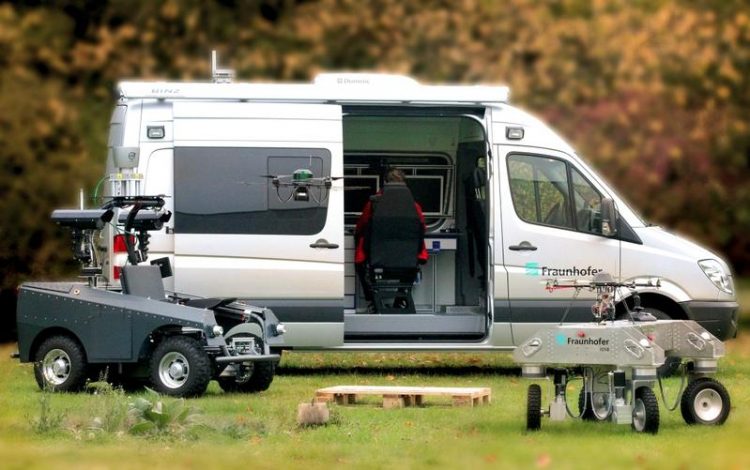SENEKA Sensor network with mobile robots for disaster management

The mobile ground surveillance and control station in a van and various ground robots (UGV) and airborne robots (UAV) Fraunhofer IOSB 2014
This year again people are suffering from severe natural disasters. Where tidal waves, earthquakes or severe storms wreak havoc in towns, villages and agricultural land, peoples’ plight is always great. The key challenge in managing large-scale natural disasters is to provide rapid and comprehensive reconnaissance of the situation to facilitate a swift, targeted search for victims and identify access routes for emergency services.
Where industrial or facilities are affected, the area may be additionally contaminated by radioactivity or leaking toxins. Although a rapid rescue of victims is essential, sources of danger to the rescuer must also be detected as quickly as possible. Here networked robots and sensors can pay a valuable contribution.
State of the art
The conventional methods used in disaster management, which are characterized by human rescuers and dogs, fall increasingly short of being able to meet the complex requirements posed by such events. Initial experience during rescue work at the destroyed World Trade Center in New York proved that the use of robots and sensors results in a more efficient search for victims and sources of danger and relieves the emergency services.
For an efficient and effective disaster management, it is advisable to have several different robots and sensors on the ground and in the air enter the affected area. These communicate with each other over wireless connections, are equipped depending on the situation at hand and are dynamically networked with the rescue teams. The resulting division of labor and information exchange allows reconnaissance and rescue work to be conducted more rapidly. To date there are no practicable solutions on the market.
Networked unmanned aerial and ground vehicles support the rescue forces
For particularly large disaster areas, the SENEKA concept accelerates the situation assessment because the sensors and robots distributed across the area can interlink to form cooperative teams (swarm intelligence). The parallelization of tasks and the use of synergy effects (for example by combining local- and wide-area reconnaissance sensors) facilitate a faster, more targeted and situation-specific search for victims and hazards. One moving ground sensor platform (UGV), for example, can be accompanied by one airborne sensor platform (UAV), such as a quadrocopter. The aerial perspective of the UAV is helping the UGV to find its way and search for victims.
Using a staged disaster scenario, the SENEKA concept is already being tested.
The project consortium regulary assesses the functionality and performance of the SENEKA concept and prototype components under close consultation of important end users (THW and the fire departments of Mannheim and Berlin). In order to proof the functionality and performance of the SENEKA concept at the end of 2014 a comprehensive realistic use case will be employed at the test site of the Federal Office of Civil Protection and Disaster Assistance (BBK) in Ahrweiler.
The SENEKA project aims to pay a substantial contribution to closing the gap between research and practical usage with the new possibilities offered by the new information, sensor and robot technologies. The complementary skills and extensive experience of the participating Fraunhofer Institutes IOSB, IAIS, IIS, IPM, and IPA create a good basis for achieving the ambitious objectives of SENEKA.
Through targeted strategic investments an infrastructure (various UAV, UGV, mobile control centers,wireless s-net components, 2D/3D cameras, LIDAR, and navigation and hazardous material sensors) was created in advance, which further strengthens the success chances of the SENEKA project. With these resources the consortium has a unique basis for its planned ambitious project that is unique in Germany. Involved in the SENEKA projects are Fraunhofer Institutes Optronics, System Technologies and Image Exploitation IOSB in Karlsruhe (Project Management) and Ilmenau, Manufacturing Engineering and Automation IPA in Stuttgart, Intelligent Analysis and Information Systems IAIS in Sankt Augustin, Integrated Circuits IIS in Erlangen and Physical Measurement Techniques IPM in Freiburg.
At CeBIT Fraunhofer will present the SENEKA project at its stand in Hall 9.
Further information and images under:
http://www.iosb.fraunhofer.de/servlet/is/20222/
Media Contact
All latest news from the category: Information Technology
Here you can find a summary of innovations in the fields of information and data processing and up-to-date developments on IT equipment and hardware.
This area covers topics such as IT services, IT architectures, IT management and telecommunications.
Newest articles

Silicon Carbide Innovation Alliance to drive industrial-scale semiconductor work
Known for its ability to withstand extreme environments and high voltages, silicon carbide (SiC) is a semiconducting material made up of silicon and carbon atoms arranged into crystals that is…

New SPECT/CT technique shows impressive biomarker identification
…offers increased access for prostate cancer patients. A novel SPECT/CT acquisition method can accurately detect radiopharmaceutical biodistribution in a convenient manner for prostate cancer patients, opening the door for more…

How 3D printers can give robots a soft touch
Soft skin coverings and touch sensors have emerged as a promising feature for robots that are both safer and more intuitive for human interaction, but they are expensive and difficult…





















